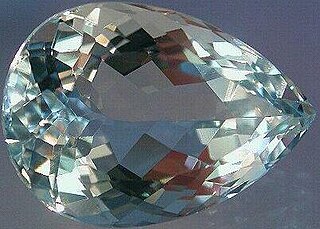Gallery
- Pendeloque-shaped earrings.
- Leaf-shaped pendeloque prisms on a chandelier.
- Drop-shaped pendeloque prisms on a chandelier.
A pendeloque, from French pendeloque, is a hanging often drop- or pear-shaped object or pendant used as an ornamentation, [1] [2] such as drop-shaped pendant earrings, [3] [4] and specific pear- and drop-shaped parts of chandeliers. [5] [6] The term is also used in describing the specific pendeloque cut for gemstone cutting. [7]
An era is a span of time defined for the purposes of chronology or historiography, as in the regnal eras in the history of a given monarchy, a calendar era used for a given calendar, or the geological eras defined for the history of Earth.
Jargon, or technical language, is the specialized terminology associated with a particular field or area of activity. Jargon is normally employed in a particular communicative context and may not be well understood outside that context. The context is usually a particular occupation, but any ingroup can have jargon. The key characteristic that distinguishes jargon from the rest of a language is its specialized vocabulary, which includes terms and definitions of words that are unique to the context, and terms used in a narrower and more exact sense than when used in colloquial language. This can lead outgroups to misunderstand communication attempts. Jargon is sometimes understood as a form of technical slang and then distinguished from the official terminology used in a particular field of activity.
Webster's Dictionary is any of the US English language dictionaries edited in the early 19th century by Noah Webster (1758–1843), a US lexicographer, as well as numerous related or unrelated dictionaries that have adopted the Webster's name in his honor. "Webster's" has since become a genericized trademark in the United States for US English dictionaries, and is widely used in dictionary titles.

Merriam-Webster, Incorporated is an American company that publishes reference books and is mostly known for its dictionaries. It is the oldest dictionary publisher in the United States.

A bucket is typically a watertight, vertical cylinder or truncated cone or square, with an open top and a flat bottom, attached to a semicircular carrying handle called the bail.

Bulgogi is a gui made of thin, marinated slices of meat, most commonly beef, grilled on a barbecue or on a stove-top griddle. It is also often stir-fried in a pan in home cooking. Sirloin and rib eye are frequently used cuts of beef for the dish. Bulgogi is a very popular dish in South Korea, where it can be found anywhere from upscale restaurants to local supermarkets as pan-ready kits.

A chandelier is an ornamental lighting device, typically with spreading branched supports for multiple lights, designed to be hung from the ceiling. Chandeliers are often ornate, and they were originally designed to hold candles, but now incandescent light bulbs are commonly used, as well as fluorescent lamps and LEDs.

The past is the set of all events that occurred before a given point in time. The past is contrasted with and defined by the present and the future. The concept of the past is derived from the linear fashion in which human observers experience time, and is accessed through memory and recollection. In addition, human beings have recorded the past since the advent of written language.

A girandole is an ornamental branched candle holder consisting of several lights that may be on a stand or mounted on the wall, either by itself or attached to a mirror. Girandole has been used to refer to a number of different objects and designs; the early girandoles were candelabras decorated with crystals looking like a chandelier on a stand, and at one time it was also used to describe all candelabras and chandeliers, with or without crystals. Girandole first appeared in France in the mid-17th century as a luxurious object for lighting. In the 18-century, a girandole may be attached to a mirror, and large wall-mounted girandoles with a mirror incorporated became fashionable in England in the second half of the 18th century. A form of girandole backed with a round convex mirror was also popular in the United States in the early 19th century.

A candelabrum is a candle holder with multiple arms. "Candelabra" can be used to describe a variety of candle holders including chandeliers. However, candelabra can also be distinguished as branched candle holders that are placed on a surface such as the floor, stand, or tabletop. The chandeliers, on the other hand, are hung from the ceiling.

Harry Winston was an American jeweler. He donated the Hope Diamond to the Smithsonian Institution in 1958 after owning it for a decade. He also traded the Portuguese Diamond to the Smithsonian in 1963 in exchange for 3,800 carats of small diamonds.
A standard operating procedure (SOP) is a set of step-by-step instructions compiled by an organization to help workers carry out routine operations. SOPs aim to achieve efficiency, quality output, and uniformity of performance, while reducing miscommunication and failure to comply with industry regulations.

Merriam-Webster's Words of the Year are words of the year lists published annually by the American dictionary-publishing company Merriam-Webster, Inc. The lists feature ten words from the English language. These word lists started in 2003 and have been published at the end of each year.
A chandlery was originally the office in a wealthy medieval household responsible for wax and candles, as well as the room in which the candles were kept. It could be headed by a chandler. The office was subordinated to the kitchen, and only existed as a separate office in larger households.

Elizabeth II owned a historic collection of jewels – some as monarch and others as a private individual. They are separate from the gems and jewels of the Royal Collection, and from the coronation and state regalia that make up the Crown Jewels.

A briolette is a style of gemstone cut. It is an elongated, mostly symmetrical along the main axel, pear shape covered with angular facets usually with a pointed end and no girdle. It is often drilled to hang as a bead. The name is also sometimes erroneously used for pendeloque cut gems. While the briolette is a symmetrical drop shape, the pendeloque cut is flatter and has two different sides: one with a large table facet and one with a point or ridge. The top of a briolette is attached to the piece of jewelry, usually by a hole drilled in the stone, and a pendeloque cut stone needs to be mounted in a prong setting. The briolette is one of the drop cuts for gemstones.

A pendeloque cut is a pear-shaped modification of the round brilliant cut used for diamonds and other gemstones. The pendeloque cut is sometimes erroneously called briolette cut, another drop-shaped cutting design. While the briolette is a symmetrical drop shape, the pendeloque cut is flatter and has two different sides: one with a large table facet and one with a point or ridge. The top of a briolette is attached to the piece of jewelry, usually by a hole drilled in the stone, and a pendeloque cut stone needs to be mounted in a prong setting. The pendeloque is one of the drop cuts for gemstones.

Diana, Princess of Wales, owned a collection of jewels both as a member of the British royal family and as a private individual. These were separate from the coronation and state regalia of the crown jewels. Most of her jewels were either presents from foreign royalty, on loan from Queen Elizabeth II, wedding presents, purchased by Diana herself, or heirlooms belonging to the Spencer family.